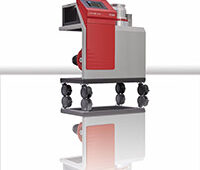 Titration is a method of determining the concentration of a substance, otherwise known as volumetric analysis. The substance for which the concentration is to be determined is known as the analyte. The analyte is in a solution at an initially unknown concentration. A substance is added that is known to react with the analyte (a reagent); this is referred to as a titrant or titrator. Measured quantities of titrant are added to the solution, causing an observable reaction with the analyte. When adding an additional quantity of titrant to the solution no longer produces a reaction, all of the analyte has been reacted. The volume of titrant that reacted with the analyte is known as the titration volume. The volume of analyte in the sample can be determined from the titration volume. If the volume of the original sample is known, then the concentration of the analyte can therefore be simply calculated.
Titration is a method of determining the concentration of a substance, otherwise known as volumetric analysis. The substance for which the concentration is to be determined is known as the analyte. The analyte is in a solution at an initially unknown concentration. A substance is added that is known to react with the analyte (a reagent); this is referred to as a titrant or titrator. Measured quantities of titrant are added to the solution, causing an observable reaction with the analyte. When adding an additional quantity of titrant to the solution no longer produces a reaction, all of the analyte has been reacted. The volume of titrant that reacted with the analyte is known as the titration volume. The volume of analyte in the sample can be determined from the titration volume. If the volume of the original sample is known, then the concentration of the analyte can therefore be simply calculated.
Instruments used for titration
Instruments used for titration include beakers, Erienmeyer flasks, pipettes, and burettes. First a pipette or burette is used to dispense and accurate quantity of analyte into a beaker or flask. A small quantity of indicator is then added to ensure that the end of the reaction will be observable. For example, for acid-base titrations, phenolphthalein is often used. If the analyte is highly concentrated, it may also be diluted at this stage. The titrant is then added is small measured quantities, typically using a pipette or burette. When titrant saturation is reached, indicating the end of titration, the indicator will change color.
Burettes
A burette is a long glass tube with a valve at one end to control the flow of liquid and graduations to measure the quantity of liquid inscribed along the length of the tube. The smaller the diameter of the tube, the more precisely the burette can dispense fluid. In a volumetric burette, when the valve is opened, fluid flows along the tube due to gravity. Liquid burettes therefore have the valve at the bottom, while gas burettes use a liquid to displace gas. Piston burettes can be even more accurate, using either graduations along the cylinder or a digital readout from a linear encoder. The movement of the piston may be actuated through a mechanical wheel or a stepper motor.
Pipettes
Traditional pipettes consist of a glass tube which narrows towards an opening at one end. The other end of the tube is enclosed by a flexible bulb. When the bulb is compressed between finger and thumb, air is expelled, priming the pipet to be loaded with liquid. The tip is emersed in a liquid and the bulb released to draw liquid up the tube. Slowly squeezing the bulb again releases the liquid drop-by-drop.
In modern usage, the term pipette covers a wide range of instruments for the accurate delivery of small quantities of liquid, including volumetric pipettes, graduated pipettes and electronic pipettes.





Tell Us What You Think!